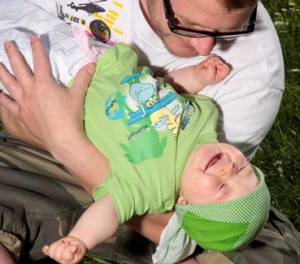An Amazing Parenting Insight Learned in Three Parts
I love research with infants. I find research it amazing and so very informative…and funny at times. One of my favorite studies is unpublished and came in three parts. I heard a conference speaker describe it. Let me share it with you.
 Part 1. An infant is seated in an appropriate chair at a table on which two toys rest. An adult enters the room and sits at the table across from the infant. He makes eye contact with the infant. He interacts and connects with the infant. After the relationship is established, the researcher picks up a toy and engages the infant in play with that toy. Then he puts the toy back in its spot and leaves. A second adult enters the room. He, too, makes eye contact with the infant. He engages the infant in an interaction. After the connection is established, he looks quizzically at the two toys and then at the infant. The infant turns to and reaches for the toy the first adult had play with. Together, the infant and second adult enjoy playing with that toy. Part one, in and of itself, is not surprising so far, but…
Part 1. An infant is seated in an appropriate chair at a table on which two toys rest. An adult enters the room and sits at the table across from the infant. He makes eye contact with the infant. He interacts and connects with the infant. After the relationship is established, the researcher picks up a toy and engages the infant in play with that toy. Then he puts the toy back in its spot and leaves. A second adult enters the room. He, too, makes eye contact with the infant. He engages the infant in an interaction. After the connection is established, he looks quizzically at the two toys and then at the infant. The infant turns to and reaches for the toy the first adult had play with. Together, the infant and second adult enjoy playing with that toy. Part one, in and of itself, is not surprising so far, but…
Part 2. Again, an infant is seated in an appropriate chair at a table on which two toys rest. An adult enters the room and sits at the table across from the infant. He does NOT make eye contact with the infant. He does NOT engage the infant in an interaction. He does NOT connect in any way with the infant. He simply picks up a toy and plays for a short time, returns the toy to its spot, and leaves. A second adult enters the room. He makes eye contact with the infant, engages the infant in an interaction, and enjoys a connection with the infant. He then looks quizzically at the two toys and the infant. The infant does not respond by pointing out a toy. The infant does not seem to know which toy to pick. Without a connection, the infant did not learn which toy was best. He did not learn which toy to pick and has nothing to share with the second adult. We learn best from those with whom we have a relationship, not strangers. But, there is another, even more intriguing twist ahead in…
Part 3 (my favorite part). Same scenario—an infant sits at a table that has two toys on it. An adult sits across the table, makes eye contact with the infant and engages the infant in an interaction. Once the connection is established, the adult picks up a toy and begins to play with it. But he looks bored with the toy. He does not enjoy the toy. It was a poor choice for him. He puts the toy back in its spot and leaves. A second adult comes in and established contact with the infant. Once the connection is established, he looks from toy to toy and then to the infant. The infant picks a toy for the adult…but NOT the one the first adult was bored with. He picks the other toy! The infant recognized the first adult’s boredom and corrected for his choice when helping the second adult.
Think about what this means for our parenting practices. Our children need us to interact with them and connect with them before they learn from us. They learn out of relationship. When we have a relationship with our children, they even learn from our mistakes and can correct for that mistake in the future. You might ask, “So what?” If I were only concerned with toys, I would ask the same thing. However, if this is true for toys it is likely true for behaviors like hard work and kindness as well. It is probably true for attitudes like politeness and generosity. It is likely needed to pass on values like love and compassion. Our children need us to connect with them and form relationships with them so they can learn the important behaviors, attitudes, and values of life. In other words, our relationship with our children will shape the tomorrow in which we grow old. What kind of tomorrow will your relationship with your children create?
-0 Comment-